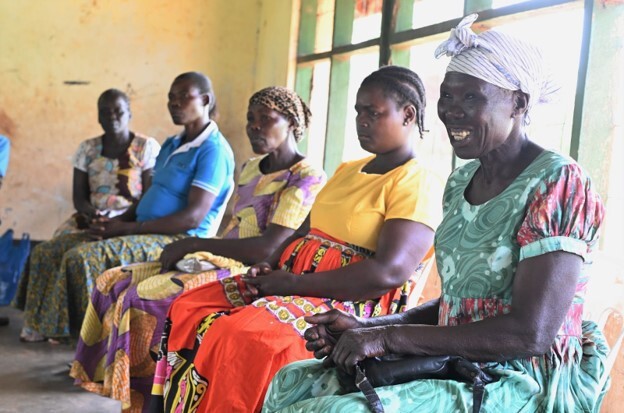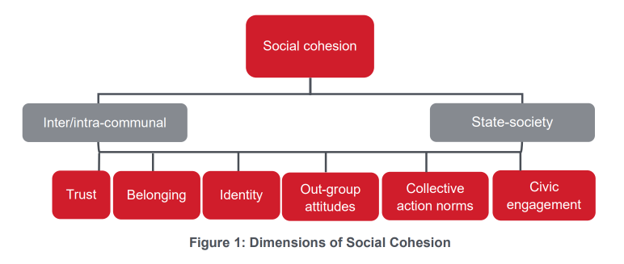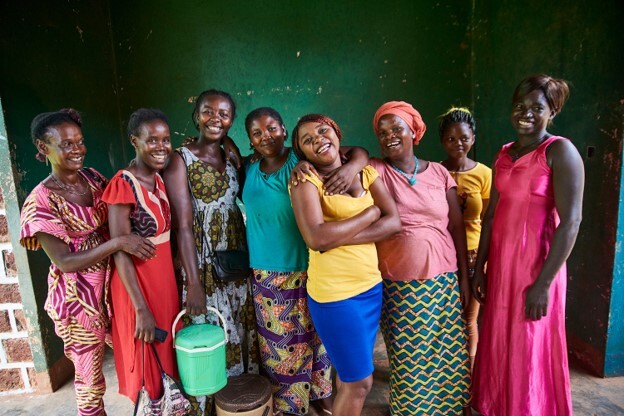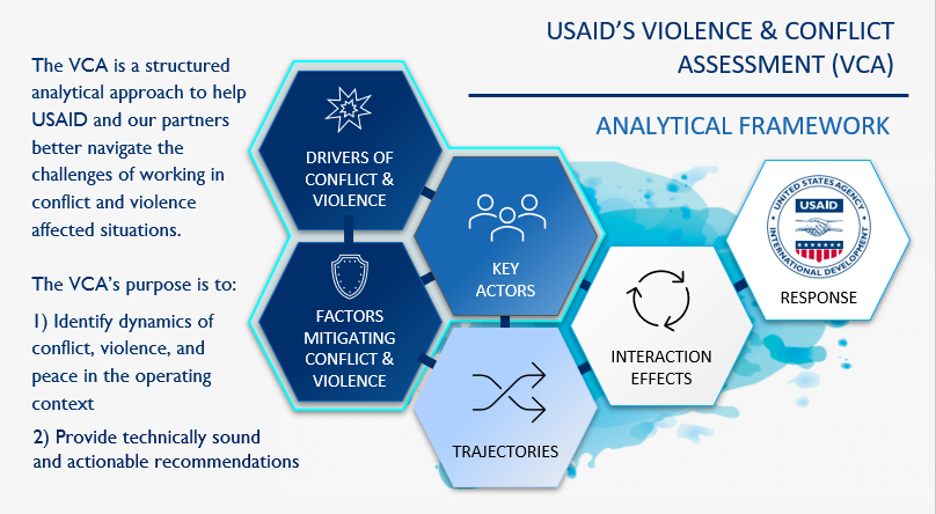 USAID/Uganda’s Peaceful Coexistence and Resilience Activity supports the Awach Community Support structure, a land dispute resolution team, composed of respected local leaders and often includes traditional chiefs, clan leaders, religious leaders, and elders trained in mediation skills. Photo: Kendra Helmer, USAID
In honor of International Day of Nonviolence on October 2, this month’s DRG Learning Digest reflects a partnership with USAID’s Center for Conflict and Violence Prevention to explore social cohesion. Social cohesion is a measure of the bonds of trust within and between groups as well as societal trust in formal and informal institutions. It provides the underpinning for a well-functioning, peaceful society by facilitating non-violent conflict resolution and helping reduce political and social tensions. It also strengthens conflict resilience by helping safeguard communities from violence when they are faced with external shocks or stresses such as climate change, economic downturns, or democratic decline. Identifying ways to foster and strengthen social cohesion should be an objective of all development assistance.
Discussed below, practitioners can help develop social cohesion in varying contexts by ensuring that their programs and activities build trust and provide opportunities for positive collaboration toward a shared goal. Importantly, research suggests that social cohesion activities are more likely to be effective when they are informed by a conflict assessment.
This edition of the DRG Learning Digest examines the following topics:
- What is social cohesion?
- How can development assistance effectively foster and strengthen social cohesion?
- Why does a conflict and violence assessment matter?
Please make use of DRG Evidence and Learning Team resources outlined below including the new DRGLinks website!
Links of materials developed by outside organizations do not represent the official view of USAID or the U.S. Government
What is Social Cohesion?
Social cohesion is a multi-dimensional concept that plays an important role in conflict and violence prevention, democracy promotion, and development. The U.S. Strategy to Prevent Conflict and Promote Stability highlights the need to use foreign assistance to strengthen social cohesion to promote stability and to achieve development outcomes. To do that, we must first understand the factors and conditions contributing to or threatening social cohesion.
While there is no universally accepted definition, researchers at the World Bank and Mercy Corps coalesced around this one: Social cohesion is “a sense of shared purpose and trust among members of a given group or locality and the willingness of those group members to engage and cooperate with each other to survive and prosper.” The figure below highlights the two different but interrelated levels of social cohesion – Intra-/intercommunal (horizontal) and state-society (vertical) – as well as the six dimensions of social cohesion. Horizontal social cohesion refers to the sense of trust, relationships, and interactions among citizens across different identities or other social constructs. Vertical social cohesion describes the relationship between the formal national and local governance structures and informal institutions.
Research investigating how best to build social cohesion in fragile, conflict, and violence-affected contexts suggests that programs should focus on both levels when possible. In their systematic evidence review, the International Initiative for Impact Evaluations (3ie) found that horizontal social cohesion between different groups is unlikely to foster sustainable peace without also strengthening the vertical relationships between society and the state. Similarly, recent qualitative research by Catholic Relief Services suggests that both vertical and horizontal social cohesion should be addressed in a harmonized manner to achieve more sustainable results.
Fostering social cohesion isn’t just a task for conflict and high-violence contexts. Building strong horizontal and vertical social cohesion helps ensure healthy interpersonal and societal dynamics regardless of the country context. By helping individuals and communities to develop effective conflict management and resilience skills, social cohesion helps prevent democratic backsliding.
 Dimensions of Social Cohesion; Source: Olawole, Lichtenheld, and Sheely (2022).
How Can Development Assistance Foster and Strengthen Social Cohesion?
Fostering social cohesion in fragile, conflict, and violence-affected contexts requires a longer-term investment in trust-building (both intercommunal and institutional) and conflict-sensitive community-driven development. Intergroup trust and faith in formal and informal institutions are not developed overnight; they are built over months and years. In post-conflict contexts, effective social cohesion interventions require sufficient time for trust to be developed, particularly when trauma remains acute.
Focusing on the design characteristics of effective social cohesion interventions, the 3ie review notes that effective interventions target multiple dimensions of social cohesion across both levels, are on average one to five years in duration, increase the opportunities for positive interactions, and address drivers of conflict identified through a conflict assessment. More specifically, the 3ie review found that effective interventions include four core features:
- Workshops that focus on conflict resolution skills development;
- Opportunities for positive intergroup contact;
- Funding for small- to medium-scale projects that are public in nature, mutually beneficial, and increase opportunities for positive intergroup interactions; and
- Take a multifaceted approach centering around relevant dimensions of social cohesion.
For example, 3ie found that workshop-based peace education programs with substantial and repeated positive intergroup contact that provide economic support for mutually beneficial and agreed upon projects can more effectively build intergroup social cohesion, especially when the activities address drivers of conflict.
A recent study on Malawi’s public works programs and social cohesion provides another example. This study presents evidence suggesting that public works programs which require a higher quantity and quality of interactions can improve vertical and horizontal social cohesion. Similarly, in Nigeria, the USAID-funded Engaging Communities for Peace in Nigeria (ECPN) project, which was geared around community-driven public works development, was shown to prevent violent conflict between farmer and pastoralist communities. The project’s impact evaluation found that its multifaceted activities improved perceptions of security and outgroup trust, and increased positive intergroup contact.
Additional research points to the importance of trust and trust-building in fostering social cohesion. To further refine programming approaches, researchers at Mercy Corps recommend that designs “emphasize trust-building around the central issues driving social tensions; prioritize the quality, not the quantity, of interactions between communities; and focus on improving government-society relations in addition to inter-group relations.” Another key finding highlights the extent to which intercommunal trust and confidence in the armed forces reduced the support for the use of violence by extremist groups.
 |
Interfaith members of the ‘Gui na mabako’ business association pose after getting a subgrant as part of the USAID-supported Interfaith Peacebuilding Partnership (CIPP) in the Central African Republic. The program is based on the principle that investments in local businesses lead to sustainable recovery and growth, examining social cohesion in the process. Photo: Sam Phelps/Catholic Relief Services.
Why Does a Conflict and Violence Assessment Matter?
Every country and region experiencing fragility, conflict, and violence is unique. Research consistently identifies the importance of a well-grounded understanding of both the context and the ways in which interventions might affect it as a critical. In fact, the 3ie systematic review notes that the majority of interventions that failed to improve social cohesion also did not conduct a conflict assessment.
By mapping key dynamics and actors in the conflict and violence landscape, assessment tools – such as the Center for Conflict and Violence Prevention’s Violence and Conflict Assessment (VCA) framework – provide information on the core fault lines between and among groups as well as areas where governance practices can be made more responsive to community needs.
The figure below presents a graphical overview of the VCA process.
VCAs identify technically sound and operationally feasible entry points for USAID assistance. They illuminate the social patterns that emerge from a country, region, or city’s conflict and violence dynamics. VCAs bring the added benefit of utilizing a conflict-sensitive lens at every stage in the process to demonstrate how development aid might interact with the local system.
VCA recommendations can help in designing medium- to long-term, community-driven interventions that target key dimensions of social cohesion in a manner that develops intercommunal and institutional trust, increases opportunities for positive interactions, and, importantly, addresses core drivers of conflict while promoting opportunities for peace.
 Violence and Conflict Assessment Analytical Framework. Source: USAID
The figure presents a graphical overview of the VCA process.
VCAs identify technically sound and operationally feasible entry points for USAID assistance. They illuminate the social patterns that emerge from a country, region, or city’s conflict and violence dynamics. VCAs bring the added benefit of utilizing a conflict-sensitive lens at every stage in the process to demonstrate how development aid might interact with the local system.
VCA recommendations can help in designing medium- to long-term, community-driven interventions that target key dimensions of social cohesion in a manner that develops intercommunal and institutional trust, increases opportunities for positive interactions, and, importantly, addresses core drivers of conflict while promoting opportunities for peace.
Further Assistance
USAID’s Center for Conflict and Violence Prevention’s Reconciliation Fund Program (RfP) is uniquely situated to help improve social cohesion in post-conflict and fragile environments. Its aim is to bring people from different communities together in positive, productive, mutually beneficial, and purposeful ways. RfP activities help address the underlying drivers of conflict, build trust and find common ground, and allow individuals and communities to engage and cooperate with each other.
You can find more information about USAID’s programs aimed at promoting social cohesion by contacting Michelle Nelson with CVP’s Reconciliation Fund Program at rfp@usaid.gov. For more information on the CVP/Violence and Conflict Assessment, please contact Tristan Willman at cpspearl@usaid.gov, and for more information about the evidence around social cohesion development in conflict contexts, contact Rick Morgan at analysisevidenceteam@usaid.gov.
Recent DRG Learning Events
Tuesday Group: Briefing on the 2023 Democracy Perception Index: How People Perceive Democracy – The Democracy Perception Index (DPI) is the world’s largest annual study of how people perceive democracy. The research, conducted by the Alliance of Democracies Foundation and Latana, seeks to provide insights into how people around the world perceive the state of democracy in their country today and the major challenges that lie ahead. On September 19, 2023, Olaf Böhnke, the Berlin Director of the Alliance of Democracies, joined the DRG Bureau to present key findings from the 2023 DPI, highlighting that while faith in democracy remains high, governments are not seen as living up to democratic expectations. His presentation explored the importance of democracy, threats to democracy, global challenges that impact democracy, and geopolitics.
Evidence and Learning Talk Series: Do Fairer Elections Promote Political Responsiveness? – Election fraud is widely believed to undermine political responsiveness. On September 21, Dr. George Ofosu from The London School of Economics, joined the DRG Bureau to share his arguments that there are theoretical and empirical reasons to doubt such an assumption and, thus, a need for a systematic test. His research provides an innovative approach to test whether and why credible elections induce political responsiveness. The study first demonstrates that election observation – a popular strategy used by civil society and international organizations to promote election fairness – limits election fraud and violence when deployed at high intensities. Focusing on legislators, the research further shows that restricting politicians' ability to rig elections encourages them to work hard to satisfy citizens' demands.
Use Our Resources!
Welcome to the DRG Learning Digest, a newsletter to keep you informed of the latest learning, evaluation, and research in the Democracy, Human Rights, and Governance (DRG) sector. Views expressed in the external (non-USAID) publications linked in this Digest do not necessarily represent the views of the United States Agency for International Development or the United States Government.
Want the latest DRG evidence, technical guidance, events and more? Check out the new https://www.drglinks.org/.
Don't forget to check out our DRG Learning Menu of Services! (Link only accessible to USAID personnel.) The Menu provides information on the learning products and services the Evidence and Learning Team offers to help you fulfill your DRG learning needs. We want to help you adopt learning approaches that emphasize best fit and quality.
The Evidence and Learning Team is also excited to share our DRG Learning, Evidence, and Analysis Platform (LEAP) with you. This Platform contains an inventory of programmatic approaches, evidence gap maps, the DRG Learning Harvest, and inventories of indicators and country data portraits - all of which can be very useful in DRG activity design, implementation, evaluation, and adaptation. The DRG Learning Harvest on LEAP is a searchable database of DRG learning products, including summaries of key findings and recommendations, drop-down menus to easily find documents related to a particular country or program area, and links to the full reports on the DEC.
Our friends at the Varieties of Democracy (V-Dem) Institute are also seeking to expand their research partnership with USAID on the complex nature of democracy by inviting research questions from you for V-Dem to work on. If there's a DRG technical question you've been wondering about, please email the Evidence and Learning Team at DRG.EL@usaid.gov.
We welcome your feedback on this newsletter and on our efforts to promote the accessibility, dissemination, and utilization of DRG evidence and research. Please visit the DRG Bureau's website for additional information or contact us at DRG.EL@usaid.gov.
|